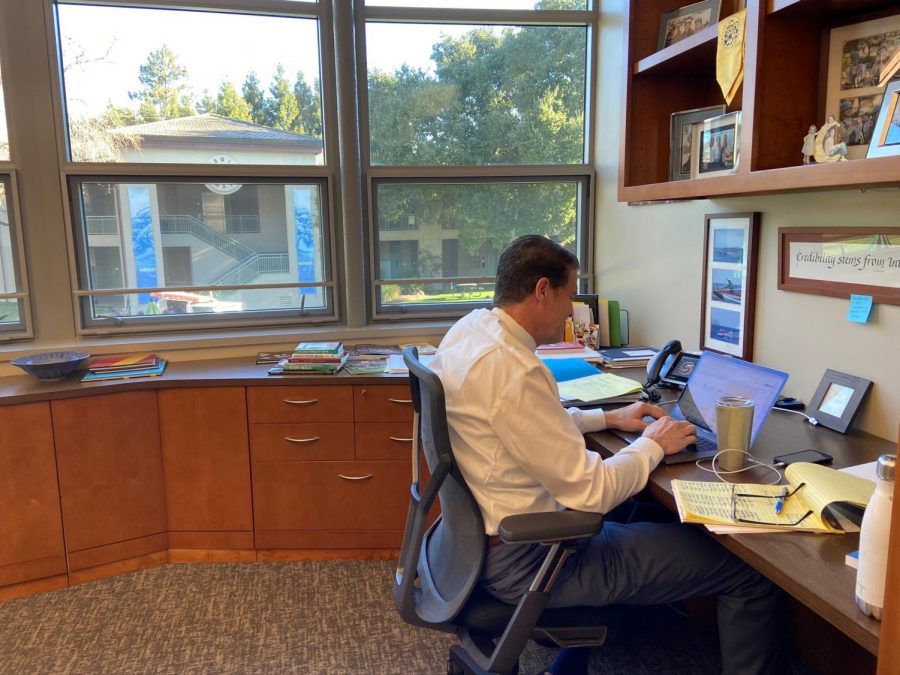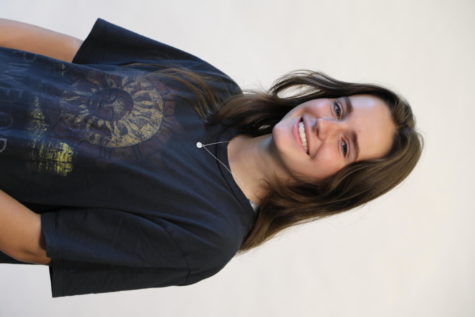Than Healy Reveals Goals for the Decade
Head of School Than Healy contemplates goals for the new decade. Staff photo: Tessa Frantz.
February 3, 2020
Going into a new year, we often hear hymns of New Year’s Resolutions among students and teachers, depicting their goals for the new year. But when entering 2020, it’s not only the start of a new year but a new decade entirely. Head of School Than Healy expressed his goals for the new year and the new decade, looking 10 years into Menlo’s future.
As a private school, Menlo is often portrayed as “transactional,” according to Healy. “I think Menlo is holding firm against [transactions]. But sometimes parents think that the point of Menlo is the byproduct: getting into college when in fact, Menlo’s role is to prepare students for life outside of school. Menlo’s education is not a transaction between the school and the parents,” Healy said. One of Healy’s main goals for the decade is to somewhat eliminate the transactional aspect of Menlo and recognize its purpose. “This education has the capacity to be transformational, maybe even change your life,” Healy said.
Financing at Menlo is also a concern for Healy and the Menlo administration. Each year, Menlo’s tuition increases significantly due to the rising housing prices in the surrounding neighborhoods. This year, Menlo tuition raised about 4.7%, according to Healy. Because almost all Menlo tuition goes directly to faculty and staff salaries, the rising prices of housing in the surrounding areas require salaries to be raised as well.
Over the course of the past six years, in response to rising housing prices, Menlo bought an apartment building in Menlo Park to house faculty. With rising rent and housing costs, it has become necessary to raise tuition. “The school has some programs that help faculty buy a house, but other than that, [faculty] are renting, which puts them at the mercy of their landlords,” Healy said. But steadily increasing tuition is also a problem, according to Healy. For middle-class families, paying Menlo’s tuition isn’t a viable option. “My worry is that we’re just going to keep pricing middle-class families out. Middle-class families who don’t qualify for aid but don’t have too much of a strain are being left out,” Healy said.
In terms of financial aid, Healy is proud of the work Menlo has done. With $6.5 million dedicated to financial aid annually, nearly 24% of students receive some form of financial aid. “I want Menlo to be a school that accepts kids who are going to be great here and who are going to make the most of this education,” Healy said.
Although many of Healy’s goals are in response to current issues, he recognizes that Menlo’s problems are relatively good problems to have in comparison to other schools. “We’re in a really luxurious place. We have high-quality problems that any other school would kill to have,” Healy said.
In a broader sense, Healy seeks to find Menlo’s significance in the world. “Looking into the future, we educate 800 kids and send off 140 kids into the world [each year], but is there more we could be doing for society?” Some of Healy’s ideas include working with public schools in the area and using Whitaker Lab as a resource for students outside of Menlo. In general, Healy seeks to expand Menlo’s broader societal role in the new decade. “A bigger existential question is: what do we do with the privilege we’ve received? What is [the school’s] role in society? I think it’s on us to consider how we benefit the broader picture,” Healy said.



